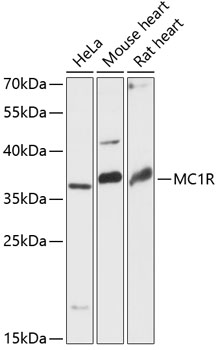Anti-MC1R Antibody (CAB13152)
- SKU:
- CAB13152
- Product type:
- Antibody
- Reactivity:
- Human
- Reactivity:
- Mouse
- Reactivity:
- Rat
- Host Species:
- Rabbit
- Isotype:
- IgG
- Antibody Type:
- Polyclonal Antibody
- Research Area:
- Cell Biology
Description
| 抗体名: | Anti-MC1R Antibody |
| 抗体コード: | CAB13152 |
| 抗体サイズ: | 20uL, 50uL, 100uL |
| 申し込み: | WB |
| 反応性: | Human, Mouse, Rat |
| 宿主種: | Rabbit |
| 免疫原: | A synthetic peptide corresponding to a sequence within amino acids 200 to the C-terminus of human MC1R (NP_002377.4). |
| 申し込み: | WB |
| 推奨希釈: | WB 1:500 - 1:2000 |
| 反応性: | Human, Mouse, Rat |
| ポジティブサンプル: | HeLa, Mouse heart, Rat heart |
| 免疫原: | A synthetic peptide corresponding to a sequence within amino acids 200 to the C-terminus of human MC1R (NP_002377.4). |
| 精製方法: | Affinity purification |
| ストレージバッファ: | Store at -20'C. Avoid freeze / thaw cycles. Buffer: PBS with 0.02% sodium azide, 50% glycerol, pH7.3. |
| アイソタイプ: | IgG |
| 順序: | LVLM AVLY VHML ARAC QHAQ GIAR LHKR QRPV HQGF GLKG AVTL TILL GIFF LCWG PFFL HLTL IVLC PEHP TCGC IFKN FNLF LALI ICNA IIDP LIYA FHSQ ELRR TLKE VLTC SW |
| 遺伝子ID: | 4157 |
| Uniprot: | Q01726 |
| セルラーロケーション: | Cell membrane, Multi-pass membrane protein |
| 計算された分子量: | 34kDa |
| 観察された分子量: | 36kDa |
| 同義語: | MC1R, CMM5, MSH-R, SHEP2 |
| バックグラウンド: | This intronless gene encodes the receptor protein for melanocyte-stimulating hormone (MSH). The encoded protein, a seven pass transmembrane G protein coupled receptor, controls melanogenesis. Two types of melanin exist: red pheomelanin and black eumelanin. Gene mutations that lead to a loss in function are associated with increased pheomelanin production, which leads to lighter skin and hair color. Eumelanin is photoprotective but pheomelanin may contribute to UV-induced skin damage by generating free radicals upon UV radiation. Binding of MSH to its receptor activates the receptor and stimulates eumelanin synthesis. This receptor is a major determining factor in sun sensitivity and is a genetic risk factor for melanoma and non-melanoma skin cancer. Over 30 variant alleles have been identified which correlate with skin and hair color, providing evidence that this gene is an important component in determining normal human pigment variation. |
| UniProt Protein Function: | Function: Receptor for MSH (alpha, beta and gamma) and ACTH. The activity of this receptor is mediated by G proteins which activate adenylate cyclase. |
| UniProt Protein Details: | Subunit structure: Interacts with MGRN1, but does not undergo MGRN1-mediated ubiquitination; this interaction competes with GNAS-binding and thus inhibits agonist-induced cAMP production. Ref.14 Subcellular location: Cell membrane; Multi-pass membrane protein. Tissue specificity: Melanocytes and corticoadrenal tissue. Polymorphism: Genetic variants in MC1R define the skin/hair/eye pigmentation variation locus 2 (SHEP2) [ MIM:266300]. Hair, eye and skin pigmentation are among the most visible examples of human phenotypic variation, with a broad normal range that is subject to substantial geographic stratification. In the case of skin, individuals tend to have lighter pigmentation with increasing distance from the equator, with type I skin being the most lightly pigmented and type IV the most dark pigmented. By contrast, the majority of variation in human eye and hair color is found among individuals of European ancestry, with most other human populations fixed for brown eyes and black hair. Partial loss-of-function mutations are associated with fair skin, poor tanning and increased skin cancer risk.MC1R variants associated with red hair and fair skin, determine female-specific increased analgesia from kappa-opioid receptor agonist [ MIM:613098]. Involvement in Disease: Melanoma, cutaneous malignant 5 (CMM5) [MIM:613099]: A malignant neoplasm of melanocytes, arising de novo or from a pre-existing benign nevus, which occurs most often in the skin but also may involve other sites.Note: Disease susceptibility is associated with variations affecting the gene represented in this entry. Ref.24 Ref.27 Sequence similarities: Belongs to the G-protein coupled receptor 1 family. |
| NCBI Summary: | This intronless gene encodes the receptor protein for melanocyte-stimulating hormone (MSH). The encoded protein, a seven pass transmembrane G protein coupled receptor, controls melanogenesis. Two types of melanin exist: red pheomelanin and black eumelanin. Gene mutations that lead to a loss in function are associated with increased pheomelanin production, which leads to lighter skin and hair color. Eumelanin is photoprotective but pheomelanin may contribute to UV-induced skin damage by generating free radicals upon UV radiation. Binding of MSH to its receptor activates the receptor and stimulates eumelanin synthesis. This receptor is a major determining factor in sun sensitivity and is a genetic risk factor for melanoma and non-melanoma skin cancer. Over 30 variant alleles have been identified which correlate with skin and hair color, providing evidence that this gene is an important component in determining normal human pigment variation. [provided by RefSeq, Jul 2008] |
| UniProt Code: | Q01726 |
| NCBI GenInfo Identifier: | 12644376 |
| NCBI Gene ID: | 4157 |
| NCBI Accession: | Q01726.2 |
| UniProt Secondary Accession: | Q01726,Q66K38, Q8WWX6, Q8WWX7, Q96I33, Q96RU4, Q9UBF7 Q9UN58, Q9UN59, Q9UN60, Q9UN61, Q9UN62, |
| UniProt Related Accession: | Q01726 |
| Molecular Weight: | 34,706 Da |
| NCBI Full Name: | Melanocyte-stimulating hormone receptor |
| NCBI Synonym Full Names: | melanocortin 1 receptor (alpha melanocyte stimulating hormone receptor) |
| NCBI Official Symbol: | MC1R |
| NCBI Official Synonym Symbols: | CMM5; MSH-R; SHEP2 |
| NCBI Protein Information: | melanocyte-stimulating hormone receptor; MC1-R; melanotropin receptor |
| UniProt Protein Name: | Melanocyte-stimulating hormone receptor |
| UniProt Synonym Protein Names: | Melanocortin receptor 1 |
| Protein Family: | Melanocyte-stimulating hormone receptor |
| UniProt Gene Name: | MC1R |
| UniProt Entry Name: | MSHR_HUMAN |


